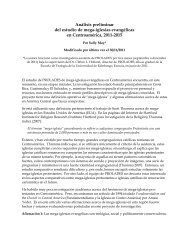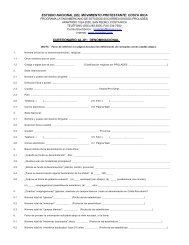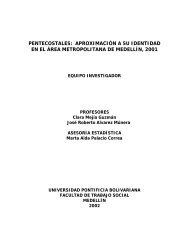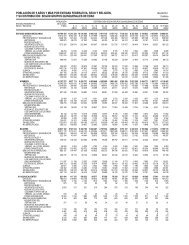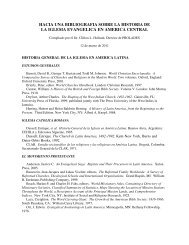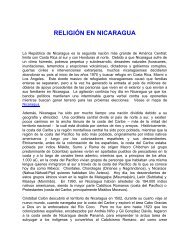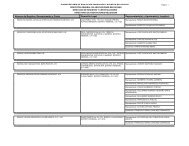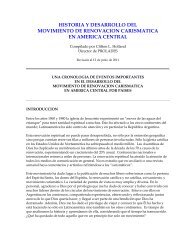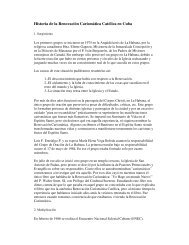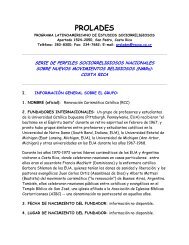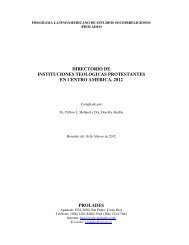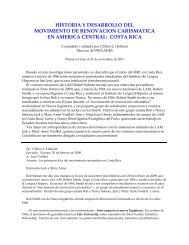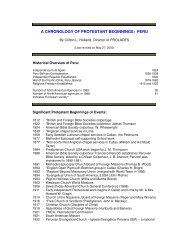belize, 1980 - Prolades.com
belize, 1980 - Prolades.com
belize, 1980 - Prolades.com
Create successful ePaper yourself
Turn your PDF publications into a flip-book with our unique Google optimized e-Paper software.
of the District shows that the total church membership increased only slightly between 1860 and<br />
1870, from 985 to 1,060.<br />
There was a decline in membership in 1870-1871 when hundreds of Belizeans, including<br />
many Methodists, migrated to Honduras to help build a railroad from Puerto Cabalero to San Pedro<br />
Sula, resulting in a depletion of Methodist congregations in Belize City and Corozal. Edward Spratt,<br />
who served the Belize Circuit from 1868 to 1872, visited Honduras to investigate to possibility of<br />
establishing Methodist work on the northern coast among the railroad workers. This field was<br />
subsequently occupied by the Wesleyan Methodist Missionary Society.<br />
Nevertheless, in British Honduras there were some encouraging signs in spite of all these<br />
difficulties. During the 1870s, Fletcher opened new stations in the northern lowlands beyond<br />
Corozal, chiefly at Orange Walk and Indian Church where evangelism was done among the Yucatan<br />
Mayas. In 1867, after the close of the American Civil War, a group of families from the defeated<br />
Southern States of the Confederacy formed an agricultural colony near Punta Gorda. Their<br />
township, known as Toledo, became a prosperous agricultural center where 12 sugar estates were<br />
established, each with its own mill. Among the colonists from Mississippi was the Rev. Levi Pearce,<br />
an ordained Methodist Episcopal Church (South) minister, who formed a Methodist congregation<br />
in the Toledo Settlement. This group established <strong>com</strong>munication with the Wesleyan Methodists in<br />
the north, and the two sister organizations united to form the Toledo Circuit, which remained strong<br />
until about 1910 when members of the settlement began to drift back to the USA, and the Toledo<br />
Settlement virtually ceased to exist.<br />
Toward the end of the 1870s, Methodist work improved in the Belize Circuit, where a second<br />
chapel was built in Belize City, but an outstanding ac<strong>com</strong>plishment of this period was the growing<br />
work among the Black Carib in the Stann Creek area. After years of sporadic efforts among the<br />
Black Carib, noteworthy progress was at last made among them when a new chapel was built at this<br />
station, with the blessing of Black Carib leaders. In 1882, the Stann Creek Circuit numbered about<br />
100 baptized church members among the Black Carib tribesmen. However, it was during the 1880s<br />
that the sugar plantations began to decline, which signaled trouble for the Toledo Circuit and for<br />
Methodist work in the Orange Walk area. Nevertheless, a chapel was constructed at Corozal in<br />
1878-1879, where work continued among the Spanish-speaking population.<br />
The Belize and Corozal Circuits were administered by Edward Gibbens and William Atkin<br />
after Fletcher's retirement and return to England in 1880. Gibbens became acting chairman of the<br />
District in January 1881, but it became necessary for him to leave Belize later that same year, and<br />
he was replaced by Joel Peters, who had 15 years experience in the West Indies. Peters, however,<br />
returned to Jamaica in 1883 and the chairmanship was passed to Atkin, who had taken Fletcher's<br />
place at Corozal. Atkin acquired a good knowledge of Spanish, often preaching three sermons in<br />
one day, and also administered the school in Corozal. Although a young man, Atkins apparently<br />
had a good grasp of the problems of the Honduran District and continued the policies inherited from<br />
Fletcher. After nine years in Belize, Atkin was transferred in 1886 to Jamaica, where he later<br />
became chairman of his district.<br />
Nevertheless, a few additional workers for the Belize field were obtained by recruiting<br />
ministers from among the local lay school teachers, such as George Alexander Frazer and<br />
Harwood Little, and from the Missionary Society who sent the Rev. James William Lord. Lord<br />
arrived in 1881 and served until 1889, mainly on the Stann Creek Circuit, where he became its first<br />
appointee. This circuit included five stations along the south coast and was attended to mainly by<br />
boat. Lord retuned for a second term in Belize from 1900 to 1910, when he became District<br />
Chairman. His mastery of Spanish allowed him to be of valuable service in Madrid from 1890 to<br />
1894, and in Barcelona after 1916. Methodist work in Belize slowly advanced during the 1880s,<br />
aided by these leaders, to whose ranks was added Thomas Nicholas Robert, who had served for<br />
45



